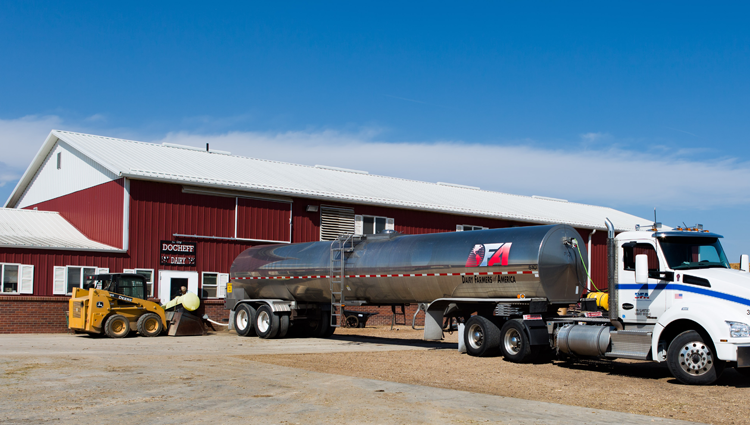Our third stop in the journey of milk from the farm to the table is raw milk transport.
On the dairy farm, equipment pumps milk directly from the milking cows to a refrigerated storage tank, where it is quickly cooled to preserve freshness and safety. It is important to note that milk never touches human hands – just one of the many food safety measures in the process of getting milk from farm to table.
Fresh milk is driven from the dairy farm to a local dairy processing plant in an insulated, sealed tanker truck. You’ve probably seen one on the highway – it is similar to a giant thermos on wheels. Some farmers produce enough milk on their farm to fill an entire tanker truck (or more!) with their farm’s milk. Other tanker trucks may stop at multiple farms to fill a load prior to heading to the processing plant.
Not only are these trucks routed by computer program to take the most efficient routes between dairy farms, they also communicate directly with dairy farmers to determine when the optimal time to pick up milk is.
Dairy farmers aim to have milk picked up when their on-farm storage capacity is nearly full – that way trucks only come as often as needed, never more. This helps save on fuel. In fact, many dairy farm families have installed larger storage tanks in recent years as the local co-op (the organization that coordinates the movement of milk off the farm and to the processing plant – a necessity due to the perishability of milk) has added new, larger capacity “quad” tanker trucks. These quad tanker trucks can pick up even more milk from more farms before stopping at the processing plant to drop off.
Every tanker load of milk is strictly tested for antibiotics both on the farm (prior to leaving) and at the processing plant (prior to being unloaded from the tanker truck). In the extremely rare event that milk tests positive for antibiotics, it is disposed of immediately and never reaches the public. Not to mention that the farmer is financially liable if antibiotics are found in their milk.
“Keep it clean, keep it cold, keep it moving” is the dairy supply chain’s mantra and this “milk cold chain” begins after milking the cow and continues through processing, distribution, retail and consumption. Because of milk’s perishability, milk moves quickly from farm to table. For 80 percent of Colorado’s milk, the journey from farm to plant is 40 miles or less and in most instances, the milk you buy in your grocery store was likely harvested on farm less than 2 days prior. Now that’s local!
Check out the full series:
- The Art and Science of Dairy from Farm to Table: An Intro
- The Art and Science of Dairy from Farm to Table: Production of Feed and Reducing Waste
- The Art and Science of Dairy from Farm to Table: Milk Production
- The Art and Science of Dairy from Farm to Table: Raw Milk Transport
- The Art and Science of Dairy from Farm to Table: Processing and Packaging
- The Art and Science of Dairy from Farm to Table: Retail and Distribution




